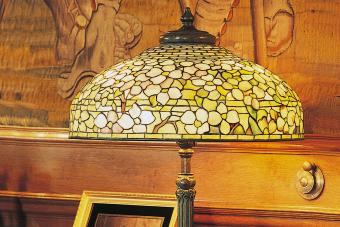
An antique Empire sofa is the ultimate find for many collectors. This beautiful piece of furniture graced the most fashionable parlors for much of the 1800s.
History of the Empire Style
The Empire style began in France during the reign of Napoleon (1804-1815). Napoleon and his court believed that by creating interest in ancient Rome, and comparing Napoleon to Augustus Caesar, they could change the French form of government from a republic to an empire without causing protest. Part of this plan was implemented by encouraging Roman inspired styles in fashion and home décor. Motifs that were symbolic of (and to) Napoleon were used decoratively along with the Roman designs.
In the early 1850s Napoleon III took control in France and Second Empire style was born. This included the motifs and design components of Empire but drew on other historic French styles including:
- Gothic
- Renaissance
- Louis XIV (also known as Baroque)
- Louis XV (also known as Rococo)
- Louis XVI (also known as Neoclassic)
The Second Empire style became popular in the United States in the 1850s and inspired fashion, architecture, and interior design for the next fifty or so years.
Motifs and Materials of Empire Style
Motifs used were those that were favored by Napoleon. The symbols he used as his own, those that represented various military coups, and were special to him in some way were carved, inlaid, and sculpted to create the Empire style. These include:
- Monograms
- Bees (symbol of Napoleon)
- Egyptian motifs
-
- Sphinx
- Winged lions
- Scarabs
- Military motifs
-
- Medals
- Trophies
- Rosettes
- Cornucopia
- Acanthus leaves
- Honeysuckle
- Animal paw feet
- Ball and Claw feet
- Scroll feet
- Dolphins
- Eagles
Many different types of materials were used in Empire and Second Empire styles, but the most popular were:
- Mahogany
- Ebony
- Papier-mache
- Cast iron
- Mother of Pearl, inlaid
- Ivory, especially inlaid
- Gilt
- Faux bamboo
- Rosewood
- Maple
Other Design Components
Other design elements that marked the Second Empire style were purely American.
- Carvings were bold and deep without a lot of detail.
- The motifs became oversized and almost over powering.
- Scrolls were structural in nature, a part of the furniture rather than just an embellishment.
- Items were stenciled.
- Geometric shapes were favored, although without the smooth lines of the Art Deco period.
- Veneers were used.
- Scroll ends and curule (X shaped) legs were used on antique Empire sofas and chairs.
Images of Antique Empire Sofas
The Empire style evolved over the years. In the beginnings of the style in America (1820s), Duncan Phyfe brought a simple Empire style to the New World. As time went on this style became more complex and luxurious.Here are some examples of antique Empire sofas from a variety of eras:
Mid-century Transition
During the late 1850s the Classical Empire style with its geometric lines was slowly transformed by the Victorian love of opulence and curves. Sofa backs became more rounded and curved. Arms were more padded and details increased. By the 1870s the sofa backs were often tufted.The number of curves on the back of the sofa could vary from a sleek and gentle curve to several, almost round design elements. In the earlier designs the top rail of the back was almost always exposed and carved. As time went on the upholstery became a larger part of the design.
This trend continued through the Victorian periods, ending in the 1920s when Art Deco and contemporary styles began to come into vogue.
Restoring an Empire Sofa
If you are lucky enough to own one of these beautiful pieces of furniture history you may find it needs some restoration. It is always best to have an appraiser look at it and advise you what needs to be done. Sometimes refinishing and other repairs can detract from the value and historical significance of the piece. There are times when it is best to leave certain signs of age alone if possible. When these repairs do need to be done it is best to have someone who specializes in antique restoration doing them.
Generally, however, re-upholstery is necessary. Some people don't care about historical accuracy when it comes to the fabric that is on their sofa. If you do want to be historically accurate then here are some tips:
- Look for signs of the original fabric. Many times there will be a piece left stuck to a nail or tack that can give you an idea of what the original color and design were.
- Look at antique sites and online museums for images of Empire sofas.
- Some fabric and upholstery sites specialize in period appropriate designs. These can be a big help if you know approximately when your sofa was made.
- Some suggested fabrics and colors are:
-
- Satin or silk Damask
- Velvet
- Tassels
- Braid
- Apple green
- Malachite green
- Gold
- Burgundy
- Royal blue
Where to Find Historical Fabric
The following shops offer a large selection of historical fabrics and fabric reproductions.
A Piece Definitely Worth Restoring
Owning a beautiful Empire sofa, or parlor set complete with chairs is the dream of many antique collectors. By taking good care of it, having it appraised, and restoring wisely you can ensure that future generations can enjoy these gorgeous pieces of furniture.







